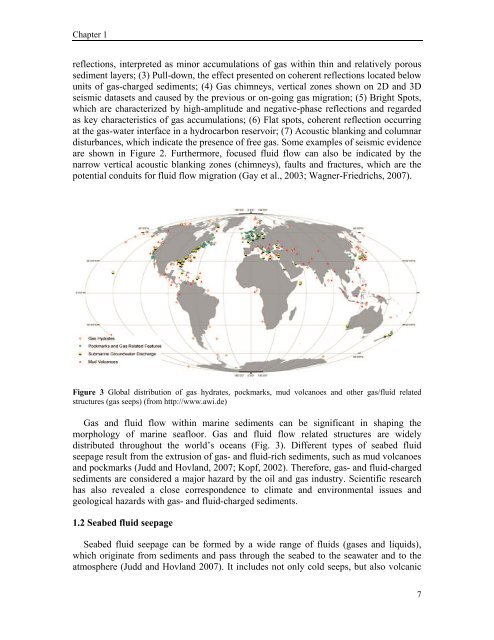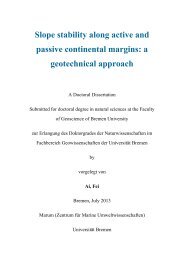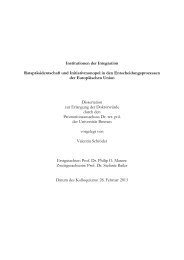Seismoacoustic Study of the Shallow Gas Transport and ... - E-LIB
Seismoacoustic Study of the Shallow Gas Transport and ... - E-LIB
Seismoacoustic Study of the Shallow Gas Transport and ... - E-LIB
You also want an ePaper? Increase the reach of your titles
YUMPU automatically turns print PDFs into web optimized ePapers that Google loves.
Chapter 1<br />
reflections, interpreted as minor accumulations <strong>of</strong> gas within thin <strong>and</strong> relatively porous<br />
sediment layers; (3) Pull-down, <strong>the</strong> effect presented on coherent reflections located below<br />
units <strong>of</strong> gas-charged sediments; (4) <strong>Gas</strong> chimneys, vertical zones shown on 2D <strong>and</strong> 3D<br />
seismic datasets <strong>and</strong> caused by <strong>the</strong> previous or on-going gas migration; (5) Bright Spots,<br />
which are characterized by high-amplitude <strong>and</strong> negative-phase reflections <strong>and</strong> regarded<br />
as key characteristics <strong>of</strong> gas accumulations; (6) Flat spots, coherent reflection occurring<br />
at <strong>the</strong> gas-water interface in a hydrocarbon reservoir; (7) Acoustic blanking <strong>and</strong> columnar<br />
disturbances, which indicate <strong>the</strong> presence <strong>of</strong> free gas. Some examples <strong>of</strong> seismic evidence<br />
are shown in Figure 2. Fur<strong>the</strong>rmore, focused fluid flow can also be indicated by <strong>the</strong><br />
narrow vertical acoustic blanking zones (chimneys), faults <strong>and</strong> fractures, which are <strong>the</strong><br />
potential conduits for fluid flow migration (Gay et al., 2003; Wagner-Friedrichs, 2007).<br />
Figure 3 Global distribution <strong>of</strong> gas hydrates, pockmarks, mud volcanoes <strong>and</strong> o<strong>the</strong>r gas/fluid related<br />
structures (gas seeps) (from http://www.awi.de)<br />
<strong>Gas</strong> <strong>and</strong> fluid flow within marine sediments can be significant in shaping <strong>the</strong><br />
morphology <strong>of</strong> marine seafloor. <strong>Gas</strong> <strong>and</strong> fluid flow related structures are widely<br />
distributed throughout <strong>the</strong> world’s oceans (Fig. 3). Different types <strong>of</strong> seabed fluid<br />
seepage result from <strong>the</strong> extrusion <strong>of</strong> gas- <strong>and</strong> fluid-rich sediments, such as mud volcanoes<br />
<strong>and</strong> pockmarks (Judd <strong>and</strong> Hovl<strong>and</strong>, 2007; Kopf, 2002). Therefore, gas- <strong>and</strong> fluid-charged<br />
sediments are considered a major hazard by <strong>the</strong> oil <strong>and</strong> gas industry. Scientific research<br />
has also revealed a close correspondence to climate <strong>and</strong> environmental issues <strong>and</strong><br />
geological hazards with gas- <strong>and</strong> fluid-charged sediments.<br />
1.2 Seabed fluid seepage<br />
Seabed fluid seepage can be formed by a wide range <strong>of</strong> fluids (gases <strong>and</strong> liquids),<br />
which originate from sediments <strong>and</strong> pass through <strong>the</strong> seabed to <strong>the</strong> seawater <strong>and</strong> to <strong>the</strong><br />
atmosphere (Judd <strong>and</strong> Hovl<strong>and</strong> 2007). It includes not only cold seeps, but also volcanic<br />
7
















